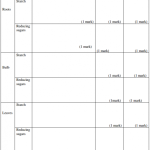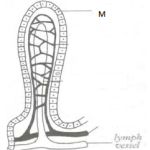KNEC KCSE Chemistry Paper 2 Question Paper / 2016 KCSE 4MCK Joint Exam
2016 KCSE 4MCK Joint Exam
Chemistry Paper 2
The following diagram shows the effects of heat on the physical states of substances
E
C
A
D
B
F
a) Identify the processes represented by the letters A,B,C,D,E, and F. (3 marks)
………………………………………………………………………………………………………
………………………………………………………………………………………………………
………………………………………………………………………………………………………
………………………………………………………………………………………………………
………………………………………………………………………………………………………
b) Name two substances that undergo the process labeled E and F (2 marks)
………………………………………………………………………………………………………
………………………………………………………………………………………………………
c) Name a method that can be used to extract the following;
i) Common salt from a salt solution. (1 mark)
………………………………………………………………………………………………………
………………………………………………………………………………………………………
ii) Paraffin from crude oil. (1 mark)
………………………………………………………………………………………………………
………………………………………………………………………………………………………
d) A student separated liquid P (B.P 78°c) and liquid Q (B.P 100°c) using the apparatus
shown below.
(i) Name the apparatus labeled
a) M…………………………………………………………………………(1 mark)
b) R …………………………………………………………………………(1 mark)
(ii) State one function of the glass bead in apparatus labeled R (1 mark)
…………………………………………………………………………………………………
…………………………………………………………………………………………………
(iii) What is the reading on the thermometer when the first few drops of the distillate
appeared in the beaker. (1 mark)
…………………………………………………………………………………………………
…………………………………………………………………………………………………
(iv) Which of the liquids remains in the flask. (1 mark)
………………………………………………………………………………………………………
………………………………………………………………………………………………………
12 marks
Study the reactions below for some organic chemistry reactions and answer the questions
that follow
H2O(l)
H+
/MnO-
4
Step I
Step VI, K(s) Step II
Step V Conc. H2SO4(l) Sodium Step III
CH3COOH
warm
Step IV
2 moles of Cl2/ uv light
(a) Name the type of reactions in step I, II, III, and V. (2 marks)
………………………………………………………………………………………………………
………………………………………………………………………………………………………
………………………………………………………………………………………………………
………………………………………………………………………………………………………
(b) Write a structural formula and give the name of the product X in step V. (2 marks)
………………………………………………………………………………………………………
………………………………………………………………………………………………………
(c) Name the products W and Z. (2 marks)
………………………………………………………………………………………………………
………………………………………………………………………………………………………
(d) Write the observations which would be made in step V. (1 mark)
………………………………………………………………………………………………………
………………………………………………………………………………………………………
(e) Write the chemical equations for each of the reactions in step (III) and (IV) (2 marks)
………………………………………………………………………………………………………
………………………………………………………………………………………………………
(f) State two uses of ethanoic acid. (2 marks)
………………………………………………………………………………………………………
………………………………………………………………………………………………………
………………………………………………………………………………………………………
………………………………………………………………………………………………………
11 marks
(a) Fractional distillation of a liquid air usually produces nitrogen and oxygen as the
major products.
(i) Name one substance that is used to remove carbon (IV) oxide from the air before
it is changed into liquid. (1 mark)
………………………………………………………………………………………………………
………………………………………………………………………………………………………
(ii) Describe how nitrogen gas is obtained from liquid air. (Boiling point nitrogen =
-196°C, Oxygen = -180°C) (3 marks)
………………………………………………………………………………………………………
………………………………………………………………………………………………………
………………………………………………………………………………………………………
………………………………………………………………………………………………………
………………………………………………………………………………………………………
………………………………………………………………………………………………………
4 marks
Study the information in the table below and answer the questions that follow. (The
letters are not the actual symbols of the element).
| Element | Electronic configuration | Ionisation KJmol-1 |
| J | 2.1 | 519 |
| K | 2.8.1 | 494 |
| L | 2.8.8.1 | 418 |
(a) (i) What is the general name of elements J,K and L (1 mark)
………………………………………………………………………………………………………
………………………………………………………………………………………………………
………………………………………………………………………………………………………
(ii) What is ionisation energy? (1 mark)
………………………………………………………………………………………………………
………………………………………………………………………………………………………
(iii) Explain why element L has lowest ionization. (1 mark)
………………………………………………………………………………………………………
………………………………………………………………………………………………………
(iv) When a piece of element K was placed on water, it melts a hissing sound was
produced as it moves on the surface of the water. Explain these observation.
(2 marks)
………………………………………………………………………………………………………
………………………………………………………………………………………………………
………………………………………………………………………………………………………
………………………………………………………………………………………………………
(v) Write an equation for the reaction between element L and water. (1 mark)
………………………………………………………………………………………………………
……………………………………………………………………………………………………
(b) One method of preparing salt is called neutralization.
(i) What is neutralization reaction? (1 mark)
………………………………………………………………………………………………………
………………………………………………………………………………………………………
(ii) Describe how you would prepare crystal of sodium nitrate starting with 200cm3 of
2M sodium hydroxide. (3 marks)
………………………………………………………………………………………………………
………………………………………………………………………………………………………
………………………………………………………………………………………………………
………………………………………………………………………………………………………
(iii) Write an equation for the reaction that takes place when a sample of sodium
nitrate is heated. (1 mark)
………………………………………………………………………………………………………
………………………………………………………………………………………………………
11 marks
a) Use the standard electrode potential for elements A, B,C, D, and F given below to
answer the questions that follow. The letters do not represent the actual symbols of the
elements.
(i) Which one is likely to be hydrogen? Give a reason for your answer. (2 marks)
………………………………………………………………………………………………………
………………………………………………………………………………………………………
………………………………………………………………………………………………………
(ii) What is the Eθ value of the strongest reducing agent? (1 mark)
………………………………………………………………………………………………………
………………………………………………………………………………………………………
(iii) Draw a labeled diagram of the electrochemical cell that would be obtained when half
cells of element B and D are combined. (3 marks)
(b)During the electrolysis of aqueous copper(II) sulphate using copper electrodes, a current of
0⋅2 amperes was passed through the cell for 5 hours.
(i) Write an ionic equation for the reaction that took place at the anode. (1 mark)
………………………………………………………………………………………………………
………………………………………………………………………………………………………
(ii) State the observation which would be made at the anode. (1 mark)
………………………………………………………………………………………………………
………………………………………………………………………………………………………
(iii)Determine the mass of the copper which would be deposited at the cathode (Cu 63⋅5)
(3 marks)
………………………………………………………………………………………………………
………………………………………………………………………………………………………
………………………………………………………………………………………………………
………………………………………………………………………………………………………
10 marks
Aluminium is extracted using the electrolytic cell represented by the diagram below.
a) Why is aluminium extracted by electrolytic method. (1 mark)
………………………………………………………………………………………………………
………………………………………………………………………………………………………
b) Name the electrodes labeled X and Y (1 mark)
………………………………………………………………………………………………………
………………………………………………………………………………………………………
c) The chief core from which aluminum is extracted is bauxite.
(i) Name two main impurities present in bauxite. (2 marks)
………………………………………………………………………………………………………
………………………………………………………………………………………………………
(ii) Aluminum oxide is the main component in bauxite with a melting point of
2015°C but electrolysis of molten aluminium oxide is carried out at 800°C.
Explain how this is achieved. (2 marks)
………………………………………………………………………………………………………
………………………………………………………………………………………………………
………………………………………………………………………………………………………
………………………………………………………………………………………………………
d) Write the equations for the reaction taking place at the node. (1 mark)
………………………………………………………………………………………………………
………………………………………………………………………………………………………
e) One of the electrodes is replaced periodically. Which one and why? (1 mark)
………………………………………………………………………………………………………
………………………………………………………………………………………………………
f) Duralumin (an alloy of copper, aluminum, and magnesium) is preferred to pure
aluminum in the construction of airplane. Give one property of duralumin that is
considered. (1 mark)
………………………………………………………………………………………………………
………………………………………………………………………………………………………
9 marks
a) (i) What Is the meaning of the term enthalpy of combustion? (1 mark)
………………………………………………………………………………………………………
………………………………………………………………………………………………………
(ii)The enthalpies of formation of carbon (IV) oxide, water and ethane are indicated below.
ΔHf(CO2) = -393⋅0kJmol-1
ΔHf(H20) = -286⋅0kJmol-1
ΔHf(C2H4) = +228⋅0kJmol-1
I. Draw the energy cycle diagram that links the enthalpies of formations of carbon (IV)
oxide, water and ethene and the enthalpy of combustion of ethene. (3 marks)
| Time (Min) | 0.0 | ½ | 1.0 | 1½ | 2.0 | 2½ | 3.0 | 3½ | 4.0 |
| Temperature °C | 26.0 | 26.0 | 26.0 | x | 24.5 | 24.5 | 26.0 | 26.0 | 26.0 |
(ii) Using your graph, determine the
I. Highest temperature change. (1 mark)
………………………………………………………………………………………………………
………………………………………………………………………………………………………
II. Find the heat change (2 marks)
(Specific heat capacity is 4⋅2kj kg-1k-1 and density of solution in 1⋅0g/cm3)
………………………………………………………………………………………………………
………………………………………………………………………………………………………
………………………………………………………………………………………………………
………………………………………………………………………………………………………
III. Find the molar heat of solution of potassium nitrate. (2 marks)
………………………………………………………………………………………………………
………………………………………………………………………………………………………
………………………………………………………………………………………………………
………………………………………………………………………………………………………
6 marks



